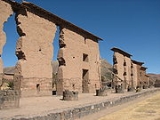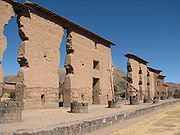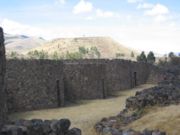
Raqchi
Encyclopedia
Raqchi is an Inca archaeological site in the Cusco region
in Peru
also known as the Temple of Wiracocha
, one of its constituents. A town nearby has the same name. Both lie along the Vilcanota (Urubamba) River
. The site has experienced a recent increase in tourism
in recent years, with 83,334 visitors to the site in 2006, up from 8,183 in 2000 and 452 in 1996.
 The most prominent structure is the Temple of Wiracocha, an enormous rectangular two-story roofed structure that measures 92 metres (301.8 ft) by 25.5 metres (83.7 ft). This structure consists of a central adobe
The most prominent structure is the Temple of Wiracocha, an enormous rectangular two-story roofed structure that measures 92 metres (301.8 ft) by 25.5 metres (83.7 ft). This structure consists of a central adobe
wall some 18 to 20 meters in height with an andesite
base. Windows and doors allow passage. It is flanked on each side by a row of eleven columns. The foundations measure 4 metres (13.1 ft) for both the wall and the columns are classic high Inca stonework with the remaining height built of adobe.
Prior to its destruction by the Spaniards, the temple had what is believed to be the largest single roof in the Incan Empire
, having its peak at the central wall, then stretching over the columns and some 25 metres (82 ft) beyond on each side. The huge proportions of the temple, and its prominence on the site explain why the whole complex is also sometimes referred to as the Temple of Wiracocha.

, that would have been used for ceremonial purposes. The storehouses are also unique as unlike other structures throughout the empire they are not square cornered. The reason for this is unknown.
Cusco Region
Cusco is a region in Peru. It is bordered by the Ucayali Region on the north; the Madre de Dios and Puno regions on the east; the Arequipa Region on the south; and the Apurímac, Ayacucho and Junín regions on the west...
in Peru
Peru
Peru , officially the Republic of Peru , is a country in western South America. It is bordered on the north by Ecuador and Colombia, on the east by Brazil, on the southeast by Bolivia, on the south by Chile, and on the west by the Pacific Ocean....
also known as the Temple of Wiracocha
Viracocha
Viracocha is the great creator god in the pre-Inca and Inca mythology in the Andes region of South America. Full name and some spelling alternatives are Apu Qun Tiqsi Wiraqutra and Con-Tici Viracocha...
, one of its constituents. A town nearby has the same name. Both lie along the Vilcanota (Urubamba) River
Urubamba River
The Urubamba River is a river in Peru. A partially navigable headwater of the Amazon River, it rises in the Andes to the south-east of Cuzco near the Puno Region border, where it is called the Vilcanota River . In the Sacred Valley, between Písac and Ollantaytambo, it is also called the Wilcamayu...
. The site has experienced a recent increase in tourism
Tourism in Peru
Tourism in Peru make up the nation's third largest industry, behind fishing and mining. Tourism is directed towards archeological monuments, ecotourism in the Peruvian Amazon, cultural tourism in colonial cities, gastronomic tourism, adventure tourism, and beach tourism. According to a Peruvian...
in recent years, with 83,334 visitors to the site in 2006, up from 8,183 in 2000 and 452 in 1996.
Layout
The complex of Raqchi consists of several different areas each designated with a specific function.Temple of Wiracocha

Adobe
Adobe is a natural building material made from sand, clay, water, and some kind of fibrous or organic material , which the builders shape into bricks using frames and dry in the sun. Adobe buildings are similar to cob and mudbrick buildings. Adobe structures are extremely durable, and account for...
wall some 18 to 20 meters in height with an andesite
Andesite
Andesite is an extrusive igneous, volcanic rock, of intermediate composition, with aphanitic to porphyritic texture. In a general sense, it is the intermediate type between basalt and dacite. The mineral assemblage is typically dominated by plagioclase plus pyroxene and/or hornblende. Magnetite,...
base. Windows and doors allow passage. It is flanked on each side by a row of eleven columns. The foundations measure 4 metres (13.1 ft) for both the wall and the columns are classic high Inca stonework with the remaining height built of adobe.
Prior to its destruction by the Spaniards, the temple had what is believed to be the largest single roof in the Incan Empire
Inca Empire
The Inca Empire, or Inka Empire , was the largest empire in pre-Columbian America. The administrative, political and military center of the empire was located in Cusco in modern-day Peru. The Inca civilization arose from the highlands of Peru sometime in the early 13th century...
, having its peak at the central wall, then stretching over the columns and some 25 metres (82 ft) beyond on each side. The huge proportions of the temple, and its prominence on the site explain why the whole complex is also sometimes referred to as the Temple of Wiracocha.
Living quarters
Adjoining the temple to the north are twelve living quarters, which would have housed both priests and local administrators. The living area is divided into separate squared lots the largest of which is roughly 4x6m. All have niches in their walls which might have been used for storage, though some of the niches have cover posts, suggesting they may have held sacred objects.
Storehouses
To the eastern side of the temple are some 100 round qolqas (storehouses) in parallel lines, each measuring some 10 metres (32.8 ft) in diameter. These storehouses were used to hold grains, such as corn and quinoaQuinoa
Quinoa , a species of goosefoot , is a grain-like crop grown primarily for its edible seeds. It is a pseudocereal rather than a true cereal, or grain, as it is not a member of the grass family...
, that would have been used for ceremonial purposes. The storehouses are also unique as unlike other structures throughout the empire they are not square cornered. The reason for this is unknown.

